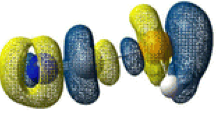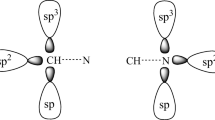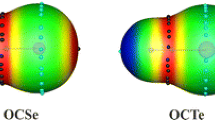Abstract
Chalcogen bonding, a Lewis acid−Lewis base attractive interaction in which a chalcogen atom (O, S, Se or Te) acts as the Lewis acid, plays a critical roles in fields as diverse as molecular biology, drug design and material engineering. In this work, ab initio calculations are performed to analyze the cooperative effects in linear (OCS) n and (OCSe) n clusters, where n = 2–8. These cooperative effects are analyzed in terms of geometric, energetic and 17O nuclear magnetic resonance (NMR) parameters and electron charge density properties of the clusters. The results of electron density analysis reveal that the capacity of the OCS and OCSe clusters to concentrate electrons at the S···O and Se···O critical points, respectively, enhances considerably with cluster size. The results also indicate that the magnitude of cooperative effects is more important for OCSe than for OCS clusters.





Similar content being viewed by others
References
Scheiner S (1997) Hydrogen bonding: a theoretical perspective. Oxford University Press, New York
Kouvatsos N, Meldrum JK, Searle MS, Thomas NR (2006) Coupling ligand recognition to protein folding in an engineered variant of rabbit ileal lipid binding protein. Chem Commun 44:4623–4625
Esrafili MD (2012) Characteristics and nature of the intermolecular interactions in boron-bonded complexes with carbene as electron donor: an ab initio, SAPT and QTAIM study. J Mol Model 18:2003–2011
Politzer P, Lane P, Concha MC, Ma YG, Murray JS (2007) An overview of halogen bonding. J Mol Model 13:305–311
Riley KE, Murray JS, Politzer P, Concha MC, Hobza P (2009) Br···O complexes as probes of factors affecting halogen bonding: interactions of bromobenzenes and bromopyrimidines with acetone. J Chem Theory Comput 5:155–163
Esrafili MD, Solimannejad M (2013) Revealing substitution effects on the strength and nature of halogen–hydride interactions: a theoretical study. J Mol Model 19:3767–3777
Bleiholder C, Werz DB, Köppel Gleiter R (2006) Theoretical investigations on chalcogen–chalcogen interactions: what makes these nonbonded interactions bonding? J Am Chem Soc 128:2666–2674
Li QZ, Li R, Guo P, Li H, Li WZ, Cheng JB (2012) Competition of chalcogen bond, halogen bond, and hydrogen bond in SCS–HOX and SeCSe–HOX (X=Cl and Br) complexes. Comput Theor Chem 980(2012):56–61
Murray JS, Lane P, Clark T, Politzer P (2007) σ-Hole bonding: molecules containing group VI atoms. J Mol Model 13:1033–1038
Murray JS, Lane P, Politzer P (2008) Simultaneous σ-hole and hydrogen bonding by sulfur- and selenium-containing heterocycles. Int J Quantum Chem 108:2770–2781
Murray JS, Lane P, Clark T, Riley KE, Politzer P (2012) σ-Holes, π-holes and electrostatically-driven interactions. J Mol Model 18:541–548
Politzer P, Murray JS, Clark T (2013) Halogen bonding and other σ-hole interactions: a perspective. Phys Chem Chem Phys 15:11178–11189
Meyer EA, Castellano RK, Diederich F (2003) Interactions with aromatic rings in chemical and biological recognition. Angew Chem Int Ed 42:1210–1250
Kusamoto T, Yamamoto HM, Kato R (2013) Utilization of σ-holes on sulfur and halogen atoms for supramolecular cation···anion interactions in bilayer Ni(dmit)2 anion radical salts. Cryst Growth Des 13:4533–4541
Wang WZ, Ji BM, Zhang Y (2009) Chalcogen bond: a sister noncovalent bond to halogen bond. J Phys Chem A 113:8132–8135
Brezgunova ME, Lieffrig J, Aubert E, Dahaoui S, Fertey P, Lebègue S, Ángyán JG, Fourmigué M, Espinosa E (2013) Chalcogen bonding: experimental and theoretical determinations from electron density analysis. Geometrical preferences driven by electrophilic–nucleophilic interactions. Cryst Growth Des 13:3283–3289
Scheiner S (2013) Detailed comparison of the pnicogen bond with chalcogen, halogen, and hydrogen bonds. Int J Quantum Chem 113:1609–1620
Iwaoka M, Takemoto S, Tomoda S (2002) Statistical and theoretical investigations on the directionality of nonbonded S···O interactions. Implications for molecular design and protein engineering. J Am Chem Soc 124:10613–10620
Bauzá A, Quiñonero D, Deyà PM, Frontera A (2013) Halogen bonding versus chalcogen and pnicogen bonding: a combined Cambridge structural database and theoretical study. CrystEngComm 15:3137–3144
Esrafili MD, Mohammadian F, Solimannejad M (2014) A theoretical evidence for mutual influence between S···N(C) and hydrogen/lithium/halogen bonds: competition and interplay between π-hole and σ-hole interactions. Struct Chem. doi:10.1007/s11224-014-0392-8
Li Q, Li R, Guo P, Li H, Li W, Cheng J (2012) Competition of chalcogen bond, halogen bond, and hydrogen bond in SCS–HOX and SeCSe–HOX (X=Cl and Br) complexes. Comput Theor Chem 980:56–61
Cozzolino AF, Vargas-Baca I, Mansour S, Mahmoudkhani AH (2005) The nature of the supramolecular association of 1,2,5-Chalcogenadiazoles. J Am Chem Soc 127:3184–3190
Alkorta I, Blanco F, Deya PM, Elguero J, Estarellas C, Frontera A, Quinonero D (2010) Cooperativity in multiple unusual weak bonds. Theor Chem Acc 126:1–14
Esrafili MD, Esmailpour P, Mohammadian-Sabet F, Solimannejad M (2013) Theoretical study of the interplay between halogen bond and lithium–π interactions: cooperative and diminutive effects. Chem Phys Lett 588:47–50
Esrafili MD (2014) Shahabivand S (2014) A theoretical evidence for cooperativity effects in fluorine-centered halogen bonds: linear (FCN)2–7 and (FNC)2–7 clusters. Struct Chem 25:403–408
Grabowski SJ, Bilewicz E (2006) Cooperativity halogen bonding effect–Ab initio calculations on H2CO···(ClF) n complexes. Chem Phys Lett 427:51–55
Alkorta I, Blanco F, Elguero J (2009) A computational study of the cooperativity in clusters of interhalogen derivatives. Struct Chem 20:63–71
Solimannejad M, Ghafari S, Esrafili MD (2013) Theoretical insight into cooperativity in lithium-bonded complexes: linear clusters of LiCN and LiNC. Chem Phys Lett 577:6–10
Esrafili MD, Hadipour NL (2011) Characteristics and nature of halogen bonds in linear clusters of NCX (X=Cl, and Br): an ab initio, NBO and QTAIM study. Mol Phys 109:2451–2460
Schmidt MW, Baldridge KK, Boatz JA, Elbert ST, Gordon MS, Jensen JH, Koseki S, Matsunaga N, Nguyen KA, Su SJ, Windus TL, Dupuis M, Montgomery JA (1993) General atomic and molecular electronic structure system. J Comput Chem 14:1347–1363
Boys SF, Bernardi F (1970) The calculation of small molecular interactions by the differences of separate total energies. Some procedures with reduced errors. Mol Phys 19:553–566
Su P, Li H (2009) Energy decomposition analysis of covalent bonds and intermolecular interactions. J Chem Phys 131:014102
Bader RFW (1990) Atoms in molecules—a quantum theory. Oxford University Press, New York
Biegler-Konig F, Schonbohm J, Bayles D (2001) AIM2000-A program to analyze and visualize atoms in molecules. J Comput Chem 22:545–559
Bulat FA, Toro-Labbe A, Brinck T, Murray JS, Politzer P (2010) Quantitative analysis of molecular surfaces: areas, volumes, electrostatic potentials and average local ionization energies. J Mol Model 16:1679–1691
Wolinski K, Hilton JF, Pulay P (1990) Efficient implementation of the gauge-independent atomic orbital method for NMR chemical shift calculations. J Am Chem Soc 112:8251–8260
Duer MJ (2002) Solid state NMR spectroscopy. Blackwell Science Ltd, London
Ziólkowski M, Grabowski SJ, Leszczynski J (2006) Cooperativity in hydrogen-bonded interactions: ab Initio and “atoms in molecules” analyses. J Phys Chem A 110:6514–6521
Grabowski SJ, Sokalski WA, Leszczynski J (2006) The possible covalent nature of N–H···O hydrogen bonds in formamide dimer and related systems: an ab initio study. J Phys Chem A 110:4772–4779
Koch U, Popelier PLA (1995) Characterization of C–H···O hydrogen bonds on the basis of the charge density. J Phys Chem 99:9747–9754
Kar T, Scheiner S (2004) Comparison of cooperativity in CH···O and OH···O hydrogen bonds. J Phys Chem A 108:9161–9168
Author information
Authors and Affiliations
Corresponding author
Rights and permissions
About this article
Cite this article
Esrafili, M.D., Mohammadian-Sabet, F. Ab initio calculations of cooperativity effects on chalcogen bonding: linear clusters of (OCS)2–8 and (OCSe)2–8 . Struct Chem 26, 199–206 (2015). https://doi.org/10.1007/s11224-014-0477-4
Received:
Accepted:
Published:
Issue Date:
DOI: https://doi.org/10.1007/s11224-014-0477-4




